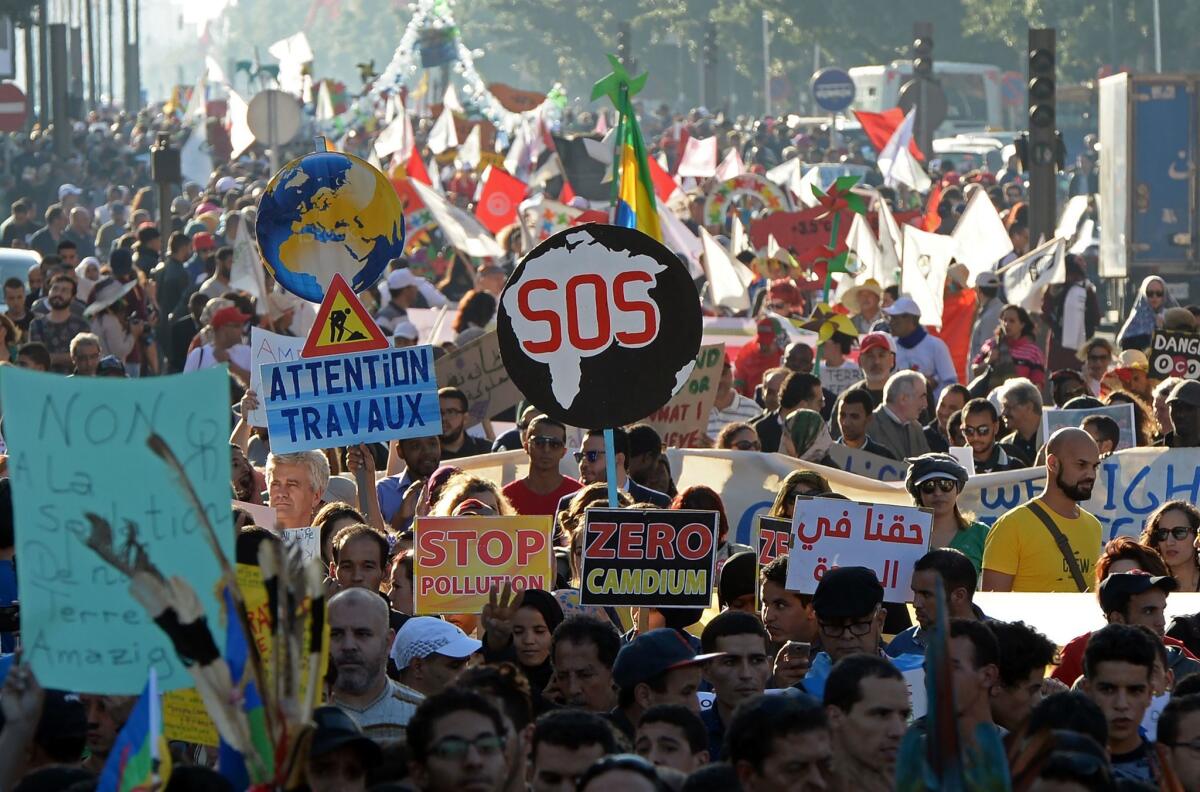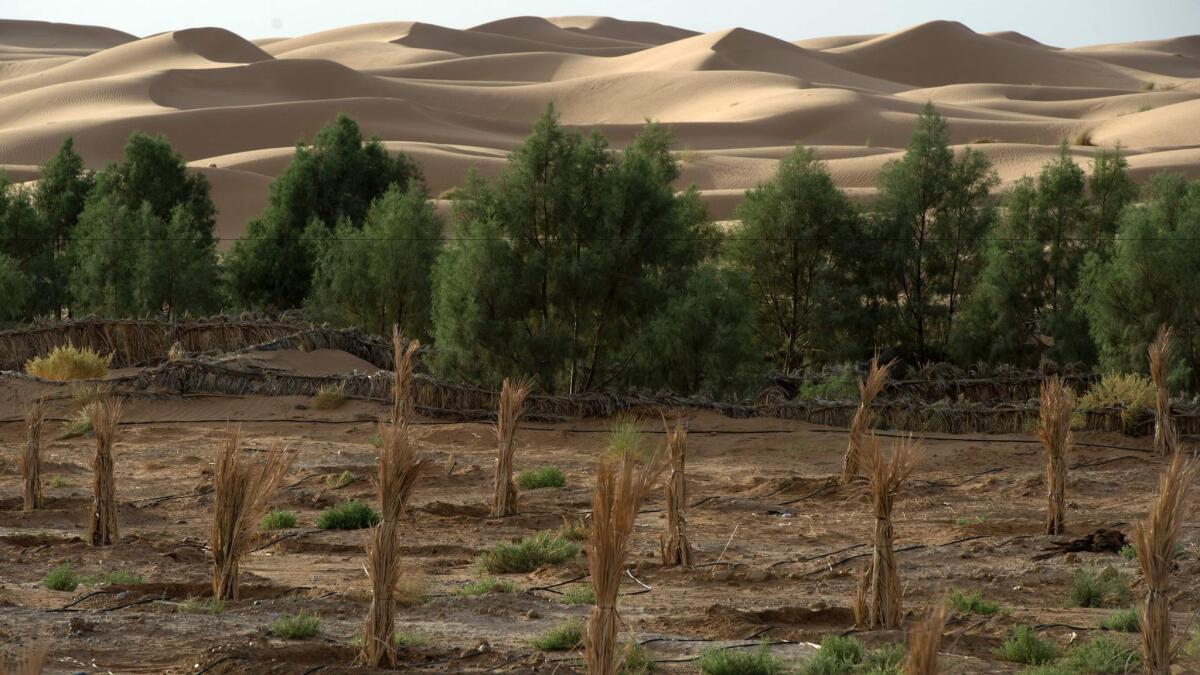One looming consequence of climate change: Small island nations will cease to exist

- Share via
As United Nations climate change talks get set to wrap up on Friday in Marrakech, Morocco, negotiators representing the Alliance of Small Island Nations underscored the need to speed up efforts to combat global warming and adapt to its effects.
“I’m happy about the progress that we are making, but we have a lot more work to do,” said Hugh Sealy, a climate change consultant for the United Nations who helped negotiate last year’s Paris agreement, which committed the world’s nations to reduce greenhouse gas emissions, and is attending the Morocco conference as the lead negotiator for small island countries.
“We are still on a trajectory for at least 3 degrees of warming even if all the countries in the world did what they promised to do,” he said. “So it’s absolutely essential that we increase our efforts and that we reduce our emissions as quickly as possible.”
Speaking from Marrakech, Sealy, a professor at St. George’s University in Grenada, shared his thoughts on the urgency of tackling climate change and the key concerns for the 44 low-lying coastal countries that are among the most vulnerable.
His comments have been edited for length and clarity.
What are small island nations hoping will come out of the conference?
Mitigation, adaptation and finance are the three key priorities for us.
The Paris agreement last year was historic because, for the first time, it locked in long-term temperature goals, like what we hope to achieve in terms of combating climate change. That’s what we call mitigation. In Paris, we agreed that we would limit global warming to 2 degrees above pre-industrial times and pursue keeping it below 1.5 degrees of warming because the small islands have clearly indicated that even 2 degrees of warming will be too much. We see 1.5 degree of warming as essential to our survival.
So at this conference, we want to move toward keeping that 1.5 degrees of warming and raising our global ambition as far as mitigation goes, which is saying we have to reduce our emissions as quickly as possible.
A second priority for us is finance. Developed countries have promised that they would give us $100 billion a year. But right now the Green Climate Fund [established by the United Nations to help developing countries counter climate change] is only financed at $10 billion over a four-year period, which is $2.5 billion a year. So we’re very, very far away from that $100 billion a year that was promised to us.
So what’s terribly important to us at this conference is that the developed countries lay out a road map as to how we’re going to get to that $100 billion a year by 2020.
The third priority for us is adaptation. And adaptation to climate change is a realization that some of the effects of climate change are already occurring. For example, sea level rise. We know we are going to face at least 1 meter (3.3 feet) of sea level rise by the end of the century. Last year was the hottest year on record. This year is headed toward breaking that record. If it does, it will of course push 2015 to second place and 2014 into third place. So we’ve had the three hottest years in a row. We are in the middle of climate change now, so being able to adapt is a huge priority for small islands as well.

What is the greatest climate change threat to small island states?
Rising sea levels, because we have the majority of our infrastructure on the coastlines — our seaports, our airports, our tourism resorts. A number of islands rely on tourism. But also, ocean acidification [is a threat]. As more carbon dioxide is absorbed into the ocean the water becomes more acidic. And as it becomes more acidic it will start to dissolve our coral reefs, and that’s disaster for us. If we lose our coral reefs, we lose our beaches. If we lose our beaches, we lose our tourism and therefore we lose our economy.
So I think most of our perils will come from the sea side of things and our coast being affected. That’s why small island nations are perhaps the most vulnerable to climate change. I would call ourselves the canaries in the coal mine. In other words, what happens to small islands will eventually occur to even larger countries. That is why for us climate change is not only an economic issue. For a lot of us, climate change is an existential issue. We will cease to exist as viable human settlements if climate change is allowed to continue in the way it is occurring now.
With the election of Donald Trump, is there concern that the U.S. might renege on its commitment to tackle climate change?
I think there are valid concerns because of what President-elect Trump said before the election. But we’re optimistic that he will realize that climate change is a global issue that America cannot divorce itself from. And we hope that the United States will continue to show the leadership that it has in the past.
What is a carbon market and how would creating a carbon market help small island nations?
It was the United States that originally used the force of markets to bring down pollution. It was President George H.W. Bush who used markets to combat acid rain. He invented a system called “cap and trade,” where he put a cap on sulfur dioxide emissions. Utility companies that were able to reduce their emissions by a significant amount got these credits and were able to sell these credits to other power companies that were not as efficient in reducing their emissions. And everyone stayed below this cap.

We are applying the same principle to carbon dioxide. You have states within the U.S., like California and some of the Eastern Seaboard states, that have created their own carbon market. Quebec in Canada has created one and it has linked itself to California. Australia is looking to join the market that the European Union has created. So we in the Caribbean … see there is a possibility under Article 6 of the Paris agreement to create our own carbon market within the Caribbean.
What are small island nations doing to combat the effect of climate change?
We are lobbying for the financing to do so. In a lot of cases our capacity to adapt is constrained. Even without this issue of climate change, we are poor developing countries that have not yet recovered from the Great Recession of 2008. We’re cash-strapped. We have sustainable development issues that we have to deal with over and above the threat of climate change.
So does the answer lie in financing?
Primarily yes. If we get enough finance then we can adapt. Of course, small islands reducing their emissions will do absolutely nothing in the global fight against climate change. You could add up all the emissions of small islands and we would probably still be less than half a percent of what the global emissions are.
For more on global development news, see our Global Development Watch page, and follow me @AMSimmons1 on Twitter
More to Read
Sign up for Essential California
The most important California stories and recommendations in your inbox every morning.
You may occasionally receive promotional content from the Los Angeles Times.











